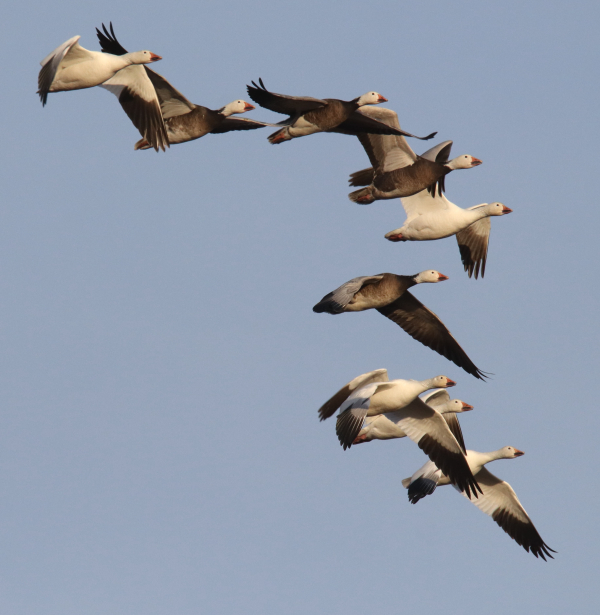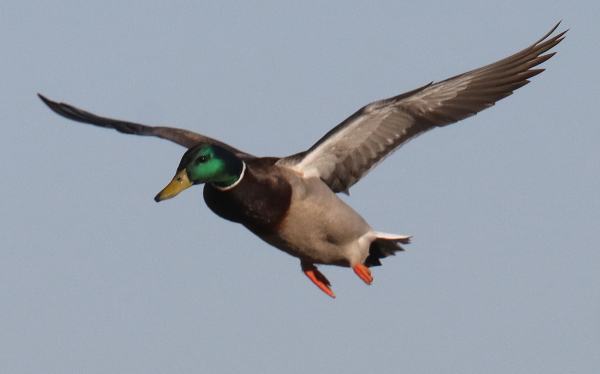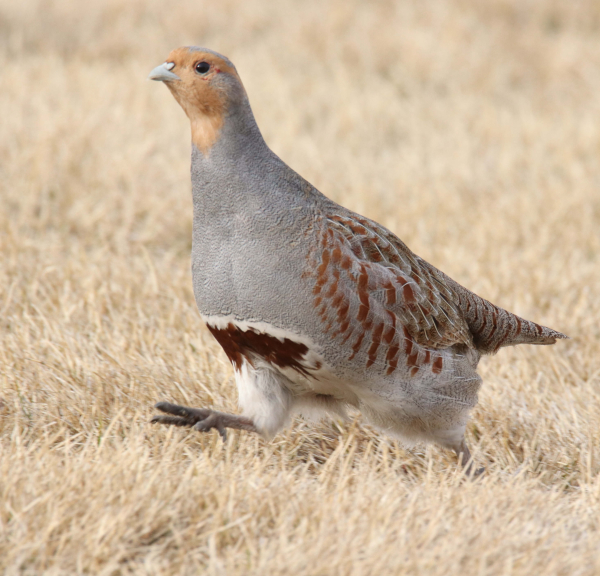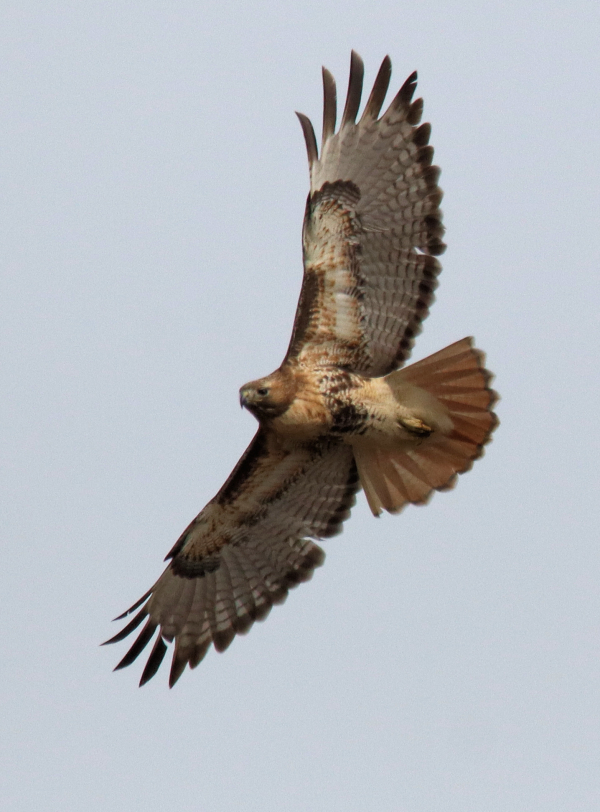
A nice mix of the 2 color morphs of Snow Geese is representative of the surges of migrating geese along the Dakota borderlands.

The first sighting of a pair of Northern Cardinals in the state – actually at the state border – resulted in a quick documentary photo of the male.

A rare Golden Eagle sighting added to Friday’s birding list, this one a yearling a few miles north of the office.

The first Western Meadowlark of spring provided a few photographs, but no songs yet.

A close look at a drake Mallard gliding into a strong headwind as it is about to land.

An action photo of a Gray Partridge was hard to overlook when selecting illustrations this week.

The brown-patterned underside of an adult Red-tailed Hawk is indicative of a forest-nesting individual during a migration stop; plains Red-tails tend to have unmarked breast and belly plumage.
|
Friday was a classic spring migration stopover day, with all 5 species of geese scattered into flocks of 100 or less, with most in the 40 to 20 bird category, and with more open water along the edges of marshes by the minute, ducks were finding spaces too, including flocks of Mallards and Northern Pintails, but also pairs of American Wigeons, Gadwalls, and Green-winged Teal. There were even 2 pairs of Tundra Swans within a mile of home on the far side of Dean’s Lake, and more than 200 Cackling Geese mixed with a few Canada Geese just a half-mile south – resting on the ice of Melody’s Marsh.
There were groups of geese like that scattered along a route that extended 5 miles north and 10 miles south of my office, with the species varying from Cackling, White-fronted, and mixed Snow and Ross’s Geese, with groups of Canada Geese trending in much smaller numbers including some pairs of Canadas. At my northern-most point of interest, Carlson Lake, there were a few small flocks of geese in flight, some seemingly displaced by a low-flying eagle.
This area is ground zero for migrating Bald Eagles during spring and fall, and I tried to get into position to photograph the now low soaring eagle, but as it elevated I could see the telltale white markings of a yearling Golden Eagle! That’s a significant sighting in my area of southeast North Dakota, where Goldens are especially rare. To illustrate that rarity, last year I observed more than 200 Bald Eagles in the area and only 1 Golden Eagle!
The current yearling Golden Eagle eventually approached my position, providing some photos as it soared ever higher, but after taking a few photos it was significant to watch with binoculars as the young Golden soared so effortlessly on high that it gave me the impression it was enjoying the ride and the view, even looking down on me in the process. At that point, about 1pm, the wind was calm with a 65 degree temperature – the warmest of the year – but by 5pm it was 34 degrees with an exceptionally strong wind at 30mph, which is a pretty dramatic turnaround.
Before the change of weather, south of my office I encountered a flock of about 25 American Tree Sparrows, 3 widely scattered Western Meadowlarks, and many male Red-winged Blackbirds, some in flocks of about 75, others seemingly already partitioning a territory among cattail stands. There were also several single Ring-billed Gulls in rapid flight across the plains, along with 2 Northern Harriers, a male on the hunt, and the first female of spring some miles apart. Last on my list was a Rough-legged Hawk, first hunting, hovering, then soaring high.
Border Birding – East & South
The previous day I drove to Fargo and appreciated a Red River birding hike. But first, on the way to Fargo I observed scattered flocks of geese north of home, along with a Red-tailed Hawk, and 2 migrating Bald Eagles, an adult and a yearling. But after turning east I only saw a migrating male Northern Harrier, a Ring-billed Gull, and a pair of Bald Eagles at annually used nest near Buffalo-Alice (there has been no sign of eagles there during earlier weeks).
At the edges of Fargo, I found some interesting birds: In my partridge study area I was surprised to see about 30 Canada Geese where I observe 2 pairs 2 weeks before, along with about 10 Mallards (1 pair before). There were 5 Gray Partridges, including 2 pairs and a single male; it appears pairs of partridges are breaking away from flocks now. The most excitement there was created by a male American Kestrel, seemingly on territory where a pair of kestrels fledged 4 young last summer. The male also represented my first kestrel sighting this spring.
On the opposite side of south Fargo, where the Red River defines the border with Minnesota, I hiked through a nature preserve that’s been created in an oxbow of the meandering river. Nature Glen was formerly owned by a friend of mine’s family, so it’s nice to see it is included in Fargo park lands now. I hiked along the many oak trees and other natives, and checked a few pine trees for Northern Saw-whet Owls. Black-capped Chickadees were most abundant, followed by Downy and Hairy Woodpeckers; and after hearing an American Robin call, 6 flew up and stopped short of the border.
After finishing my hike, I stood next to my car with the door open a moment to take in one more deep breath of the fresh air, when a red spot caught my eye. I focused my camera lens on it to see that it was, as hoped, a male Northern Cardinal, but before I could take a photo it took flight – landing much closer to my position. While cardinals are widespread from the Atlantic Coast and Gulf of Mexico to the Red River, few are seen in North Dakota, so this was a great find; in fact, this was only my second sighting in NoDak. The red bird was partly hidden in a tangle of twigs in a large tree before me, so I figured, “try pishing.” I lightly pished and although the cardinal looked my way, it didn’t budge.
That’s when a female cardinal that had eluded my detection flew from the same location past my right shoulder, so I zeroed in on the male again, expecting it to follow. It did, but not before it hopped to a more open perch and peered in my direction for a quick photo before following the female’s flight. I quickly checked my camera’s LCD screen to see the photo was respectable with a little cropping, and that’s when 2 hikers appeared. One of the college-age ladies asked if I enjoyed photographing birds, and I said yes and offered to show the photo I had just taken. The women had also seen the red spot in the tree, so were impressed to see the photo I managed. I offered my camera so they could look to see the magnification and zooming options too. It’s always fun to share birding equipment with others, including binoculars; we birders are quite good about doing that.
My other border birding trip was southeast of home, Wednesday, to check on the progress of migration 45 miles south of the border and east to the James River where it passes through Sand Lake National Wildlife Refuge. To learn more and see some of the photographs I took to document my afternoon of top-notch early spring birding activities, you can refer to the Bird Photography feature in this issue.
Homestead Visitors
As I was putting the finishing touches on last week’s issue, the familiar male Hairy Woodpecker stopped in to my feeding station after an absence. Why do I think it’s the same bird? Its unusual unique approach to the feeding platform is indicative. This time an attendant ‘first of the year’ Red-breasted Nuthatch appeared on the adjacent elm tree behind the big woodpecker, but that was ‘little red’s’ only appearance. An Oregon Dark-eyed Junco also made an appearance after a junco-less period, followed by 3 ‘regular’ Dark-eyed Juncos Wednesday.
Friday morning’s surprise was hearing a Blue Jay, but it provided no sightings. A silent Downy Woodpecker did stop by after the strong wind began, as did the male Hairy Woodpecker, a couple regular juncos, and the daily Harris’s Sparrow and House Finches. Toward the end of the day, I thought I saw a Sharp-shinned Hawk, and about an hour later that thought was underscored when a Sharp-shinned Hawk flew into view, closer, and landed in a tall blue spruce tree. Perhaps it’s the same Sharpie I’ve been seeing rarely in recent weeks; probably, based on the fact that I’ve only ever seen that 1 now and 1 a couple years ago in my yard.
Since Friday big flocks of Snow Geese passed outside my windows, adding goose music to my yard – a special part of this period of early spring. Monday a Blue Jay alerted me a couple times with loud calls near my feeding station, but it didn’t reveal itself for a sighting – until its third and fourth visits. Each of those 2 times, the jay appeared very cautious, and when it did finally launch itself to land on the platform feeder, but both times it stopped short of landing – scaredy jay!
Weekend Surprises
With remarkably strong winds for 24 hours, I didn’t expect to see much avian action Saturday afternoon, and the first 3 miles went as expected with no sightings. But at mile 3 I saw a cloud of birds a couple miles west-southwest, so I drove in that direction, short-stopped by the first female American Kestrel in the area. The cloud was composed of thousands of Snow Geese with Ross’s mixed in and outlying flocks Cackling and White-fronted Geese that were acting wildly in the gusting north wind. Actually, there were 2 clouds of geese, separated by about a mile, with some small flocks flying from one cloud to the other as they filled the sky low above a harvested cornfield, with hundreds landing at a time. But before the flock became ground bound, the geese all took flight again, repositioning again 200 yards away, and repeating that action many times over the next hour.
There was a female Northern Harrier hunting the area, a Bald Eagle flew in to perch in a lone cottonwood tree, and there were scattered small flocks of Canada Geese, Mallards, and Northern Pintails in the air too. As I moved on, I realized there was a serious influx of Cackling Geese compared to the previous day, and most Cackling flocks had some White-fronts mixed in, or Canada Geese, and there was even a lone Ross’s Goose among a Cackling flock. With very little open water available, it was exciting to see Cackling Geese and their comrades were utilizing the few open areas, with other flocks resting on lake ice or feeding in cornfields. There were quite a few flocks of small brown songbirds moving through the area, but I could only identify some flocks as American Tree Sparrows. There was also a flock of about 20 Western Meadowlarks, along with a few scattered individuals.
The clouds of Snow Geese vanished by Sunday afternoon, as did almost all of the open water areas, but I did see occasional flocks of Snow Geese as I worked in my office, just not when I took a birding break. There were still a few flocks of Cackling Geese with a small percentage of White-fronts mixed in, but most appeared to have moved from the area. Mallards and Northern Pintails remained active in one open water marsh where pintails were making nuptial flights throughout my observations. It was also interesting to see the first small flocks of Ring-billed Gulls, rather than the single birds that formed the vanguard of the species earlier.
Sunday’s surprise was finding a new Bald Eagle nest, complete with a Bald Eagle standing on the nest platform. That nest was originally built by Red-tailed Hawks and has been used by Red-tails during recent years, but Sunday the size of the nest from a distance made me stop and take a closer look with binoculars, which revealed the enlarged nest with the white-topped eagle on it. Some miles to the east, I encountered a suspicious pair of Bald Eagles standing on the ice of a large marsh, not far from another Red-tailed Hawk nest that has been enlarged, so I checked back on Monday afternoon, which revealed a Bald Eagle standing on the nest – a second new eagle nest!
Those breakthroughs encouraged me check the eagle nest I’ve been monitoring for a half-decade, which didn’t look enlarged, but there was a telltale adult Bald Eagle perched in an adjacent tree – suggesting a third nest will become active soon. I checked one other nearby nest that might attract Bald Eagles this spring, and it was empty and there were no hints of eagles, hawks, or new branches in the nest, so I’ll check back. My impression was that it is probably an especially big Red-tailed Hawk nest, but so were the 2 new eagle nests, so I’ll keep an eye on that nest site too. The fact that Bald Eagles are moving onto the open plains to nest has been especially surprising, and it’s exciting to see such a big increase in nesting pairs fairly close to home – literally tripling over previous years!
There were other raptors in the area too, including 2 American Kestrels, 2 Northern Harriers, and 3 Red-tailed Hawks. A few flocks of Cackling Geese were present in the area, with small flocks of Canada Geese scattered around; but the only flocks of Snow Geese were flying high in transit westward around noon on Monday. It’s been a week of big transitions, spring migration is happening day to day, but it’s just beginning with shifting starts and stops owing to March weather. Enjoy the first day of spring tomorrow, March 20th, and if you can, devote a little extra time to birding.
Article and Photos by Paul Konrad
Share your bird sightings and photographs at editorstbw2@gmail.com